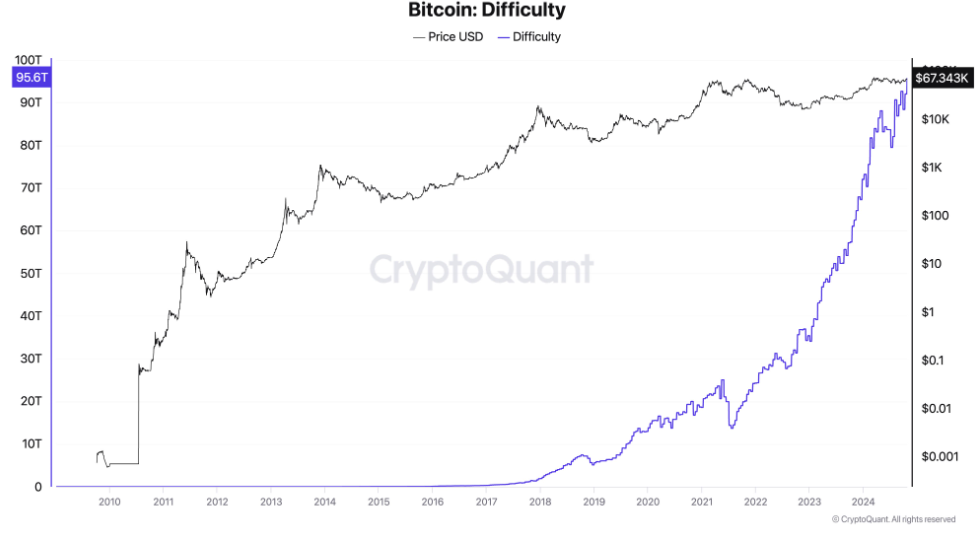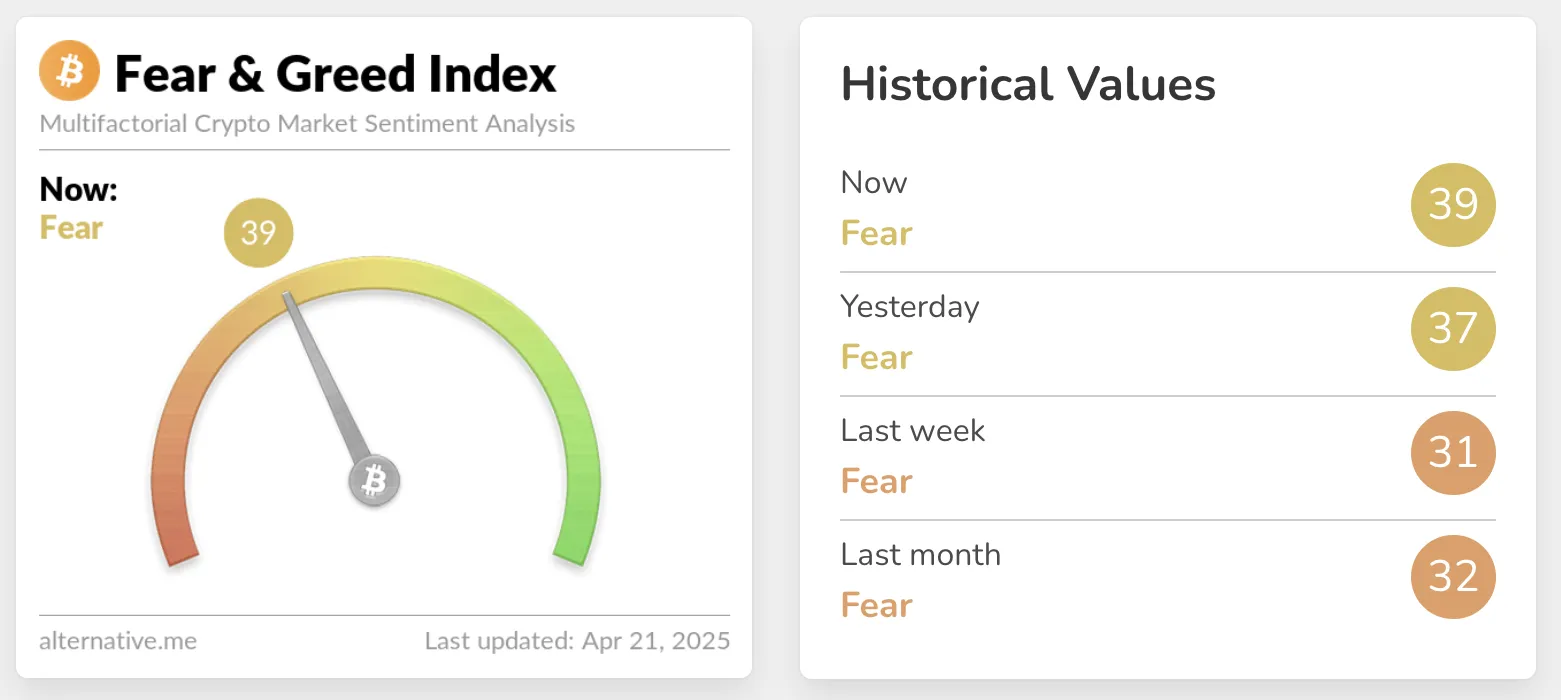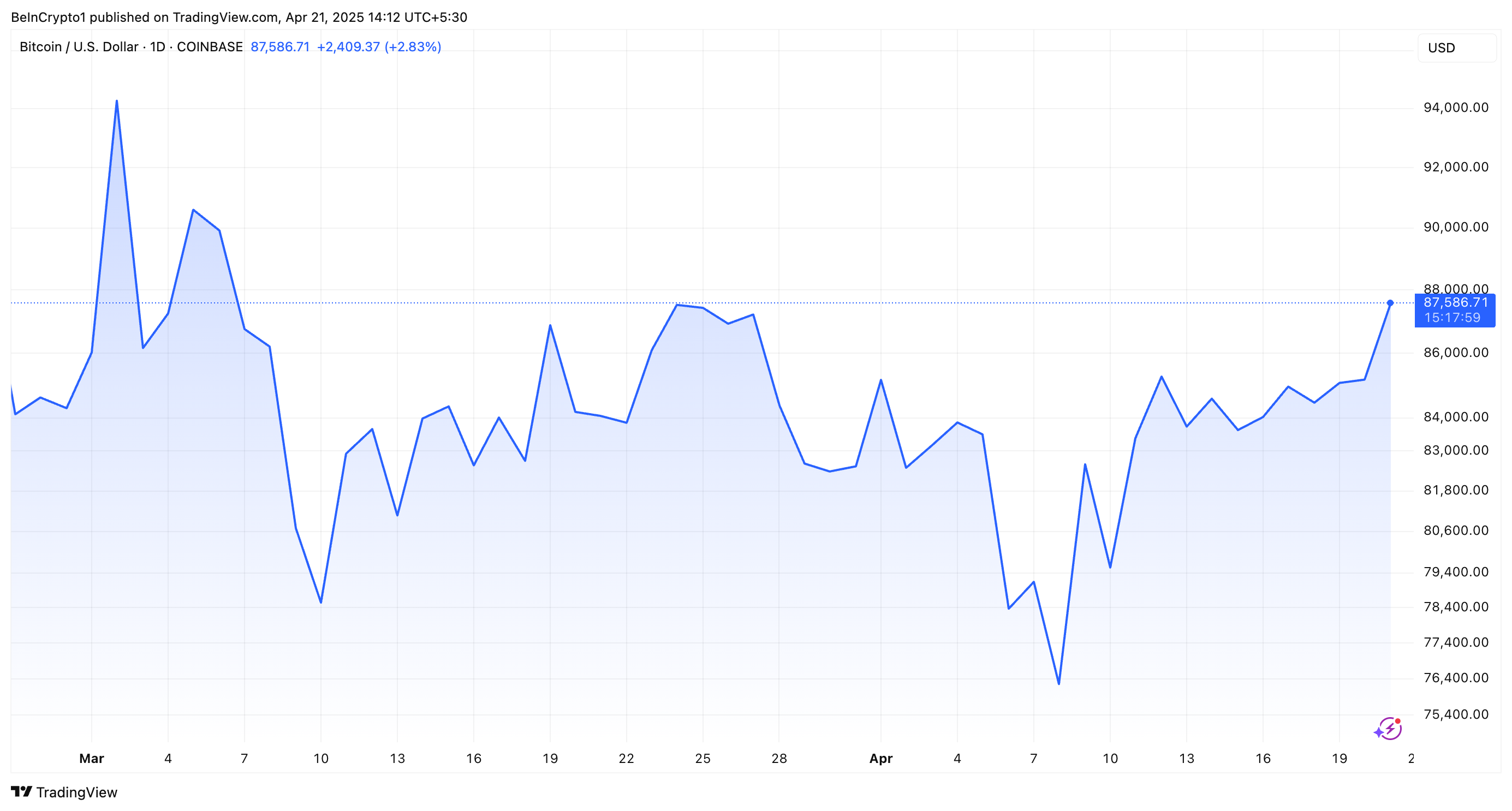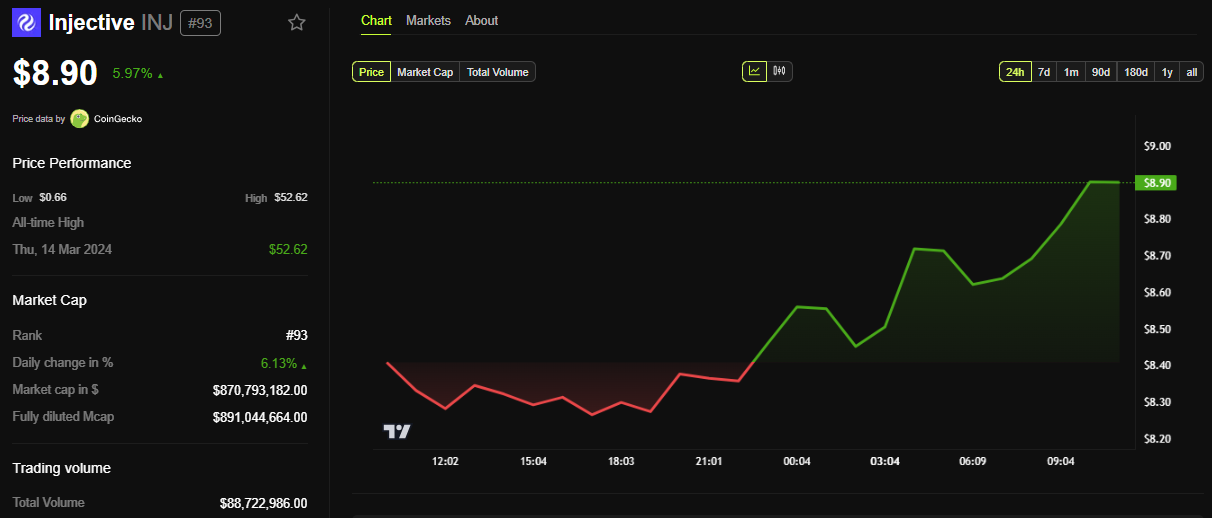Bitcoin
Bitcoin May Evolve Into a Currency by 2030

Bitcoin (BTC) could finally realize its potential as a global currency by 2030, according to a recent post by Ki Young Ju, CEO of CryptoQuant. Ki’s analysis highlights the rapid evolution of the Bitcoin ecosystem, particularly in mining and institutional involvement.
Satoshi Nakamoto, the mysterious creator of Bitcoin, once envisioned it as a decentralized, peer-to-peer (P2P) electronic cash system.
CryptoQuant Founder Envisions Bitcoin As A Future Currency
In the post on X (formerly Twitter), Ki hinted at a future where Bitcoin may be widely used as a low-volatility currency, not just a speculative investment asset. The vision is based on how Bitcoin mining has drastically changed since its inception in 2009.
Back then, individual miners could easily mine 50 BTC with a single personal computer. Today, the playing field is entirely different.
Bitcoin’s mining difficulty, which measures the complexity of mining new blocks, has surged by a staggering 378% in just the past three years. This reflects the increased competition within the industry, with the growth making it nearly impossible for individual miners to participate profitably.

Instead, large-scale mining companies backed by institutional investors now dominate the industry. This shift toward institutional control has had far-reaching consequences for Bitcoin’s future. As institutional investors take the reins, entry barriers to mining rise, and Bitcoin’s ecosystem grows more stable.
Read More: How To Buy Bitcoin (BTC) and Everything You Need To Know
Against this backdrop, Ki Young Ju suggests that stabilization could reduce Bitcoin’s infamous price volatility. Instead, it could make it less appealing to day traders but more attractive as a practical currency.
The CryptoQuant executive points to one key event – Bitcoin halving. This event occurs approximately every four years when the reward for mining Bitcoin transactions is cut in half. After the 2024 Bitcoin halving, the next one is expected to take place around April 2028.
Historically, significant price increases came after halving events. However, Ki Young Ju predicts that the 2028 halving could mark a new phase in Bitcoin’s evolution. As Bitcoin’s volatility decreases over time, the conversation around its use as a “currency” may begin in earnest by this time.
Institutional Adoption of Bitcoin To Soar By Next Halving
Ki Young Ju believes that by 2028, institutional adoption will reach a critical mass, paving the way for Bitcoin to become more widely accepted for everyday transactions. The increasing presence of major fintech companies could also play a role in Bitcoin’s transformation into a currency. For instance, Stripe’s recent foray into the stablecoin infrastructure space could draw more e-commerce and global markets.
As regulatory clarity emerges, stablecoins could see mass adoption. This could familiarize more people with blockchain wallets and other cryptocurrency-related technologies in turn.
Furthermore, volatility has long been a major barrier to Bitcoin’s use as a currency. Businesses and consumers are reluctant to use Bitcoin for transactions if its value fluctuates wildly from day to day. However, Ki Young Ju argues that this volatility is slowly decreasing as the ecosystem matures.
“As volatility decreases, Bitcoin’s role as a currency becomes increasingly inevitable,” Ju added.
This reduction may occur through advancements in protocol, Layer 2 (L2) networks, or the adoption of Wrapped Bitcoin (WBTC). Nevertheless, Ki Young Ju says for Bitcoin L2s to be competitive, they would need institutional support. As these improvements take hold, Bitcoin’s potential to serve as a stable currency grows.
This aligns with the vision of financial experts like billionaire investor Paul Tudor Jones, who sees Bitcoin as a hedge against inflation and economic uncertainty. Jones believes that Bitcoin’s finite supply, particularly in a world burdened by increasing debt and inflation, makes it an attractive store of value.
Similarly, MicroStrategy founder Michael Saylor believes Bitcoin’s unique properties make it a superior store of value over the long haul. This explains the business intelligence firm’s progressive BTC buying spree. The firm has been stacking Bitcoin since 2020 and is still holding.
This growing institutional trust could further stabilize Bitcoin’s price, enhancing its appeal as a currency by the end of the decade.
“We’re buying Bitcoin to hold it 100 years. That $66,000 to $16,000 crash shook out the tourists. When it was $16,000, we were all ready to ride it to zero,” Saylor said recently.
For Ki Young Ju, this transformation represents a return to Bitcoin’s original purpose. While many view Bitcoin as “digital gold,” Satoshi Nakamoto’s true aim was for it to function as a P2P electronic cash system.
Read more: Satoshi Nakamoto – Who is the Founder of Bitcoin?
As the ecosystem matures and volatility continues to decrease, the perception that Bitcoin cannot be a currency no longer exists. CryptoQuant’s founder believes the world could see Bitcoin used as a practical, low-volatility currency by 2030, effectively realizing Satoshi’s long-held dream.
Disclaimer
In adherence to the Trust Project guidelines, BeInCrypto is committed to unbiased, transparent reporting. This news article aims to provide accurate, timely information. However, readers are advised to verify facts independently and consult with a professional before making any decisions based on this content. Please note that our Terms and Conditions, Privacy Policy, and Disclaimers have been updated.
Bitcoin
Public Companies are Buying Bitcoin Again After a Brief Pause

Bitcoin is rebounding after tariff chaos, and public companies like Metaplanet are conducting major acquisitions. The firm bought $28.2 million worth of the asset, nearly a $2 million increase from last week.
However, despite this new confidence, Metaplanet’s stock has continued to perform shakily. The crypto market is showing cautious optimism, but that won’t immediately translate into major gains.
Although a few corporate Bitcoin whales briefly paused their big purchases recently, the markets are heating back up again. Metaplanet began buying the dip last week, and Bitcoin has been making steady progress since then.
Today, its CEO, Simon Gerovich, announced a new purchase as BTC rebounds:
“Metaplanet has acquired 330 BTC for ~$28.2 million at ~$85,605 per bitcoin and has achieved BTC Yield of 119.3% YTD 2025. As of 4/21/2025, we hold 4855 $BTC acquired for ~$414.5 million at ~$85,386 per bitcoin,” he claimed.
Trump’s tariff threats caused massive uncertainty and crypto liquidations in the last few weeks. However, since he announced a pause, crypto and industry-related stocks have been rallying.
Whales like Metaplanet and MicroStrategy immediately began buying Bitcoin, and the whole market is rising. The Crypto Fear and Greed Index was recently in Extreme Fear but has since recovered greatly:

Still, markets are showing cautious optimism, not a full rally. A quick look at some major crypto-related stocks will paint a clearer picture.
MicroStrategy rose over 4% in the last five days and nearly 6% in the last month, but it’s a pillar of confidence in BTC. Metaplanet, a much smaller Bitcoin holder, only fell 1.89% in the last five days but over 20% in the last 30.
In other words, it can be difficult to cleanly connect Bitcoin’s recent successes with major holders like Metaplanet. Compare two prominent US-based crypto miners, Marathon and Riot.
The former recovered from its slump in early April, while the latter only continued to drop. Coinbase, too, has only made brief rallies on a trend of continual decline.
While Bitcoin’s adoption has surged dramatically over the past year, there’s still a lot of uncertainty about tariffs and recession. Metaplanet may be in shaky territory right now, but its confidence in Bitcoin can provide a long-term sense of stability.
Disclaimer
In adherence to the Trust Project guidelines, BeInCrypto is committed to unbiased, transparent reporting. This news article aims to provide accurate, timely information. However, readers are advised to verify facts independently and consult with a professional before making any decisions based on this content. Please note that our Terms and Conditions, Privacy Policy, and Disclaimers have been updated.
Bitcoin
Dollar Dips While Bitcoin Hits New Heights

The US Dollar Index (DXY) has dropped to a three-year low amid reports that President Donald Trump is considering removing Federal Reserve Chairman Jerome Powell.
Meanwhile, the development positively affected Bitcoin’s (BTC) price, pushing it to its highest level since President Trump’s Liberation Day.
Trump’s Push Against Powell Adds Pressure on the Dollar
According to the latest data, DXY has plunged below 99. At press time, it stood at 98.2, representing the lowest value since March 2022.

Economist Peter Schiff highlighted the severity of the situation in the latest post on X (formerly Twitter).
“Gold is up over $50, hitting a record high of $3,380. The euro is above $1.15. The dollar has also fallen below 141 Japanese yen and .81 Swiss francs (a new 14-year low, just 3% above a record low). The dollar Index is below 98.5, a new three-year low. This is getting serious,” Schiff posted.
The dollar’s steep fall comes amid the latest comments made by National Economic Council Director Kevin Hassett on Friday, April 18. Hassett revealed that Trump and his team are actively exploring the possibility of ousting Powell.
His statement was in response to a reporter’s question about whether removing Powell was an option.
“The president and his team will continue to study that matter,” Hassett replied.
In addition, he called out the Federal Reserve for politically motivated actions under Powell’s leadership. Specifically, Hassett criticized the Fed for raising interest rates shortly after Trump’s election and cutting them ahead of the election, moves he claims favored the Democratic Party.
Notably, the growing contempt towards Powell is a response to the Fed’s stance on interest rates. BeInCrypto reported earlier that the Fed will likely not cut rates in May amid rising inflation and President Trump’s tariff pause.
Recently, Trump also blamed the Fed Chair for being slow to act on interest rate cuts. In a post on social media, Trump compared Powell’s actions unfavorably to the European Central Bank (ECB), which is set to implement its seventh interest rate cut.
Trump argued that Powell, whom he described as “always too late and wrong,” should have taken similar measures long ago to address economic conditions.
“Powell’s termination cannot come fast enough!” the President wrote.
The Fed Chair’s potential removal raises serious questions about the Federal Reserve’s independence and its implications for global markets. Powell, whose term as chair extends to May 2026, has previously stated that legal protections prevent his removal and that he intends to serve out his term.
Will Dollar Weakness Drive Bitcoin to New Heights?
Nonetheless, it’s worth noting that if Powell is removed and President Trump successfully persuades the Federal Reserve to cut interest rates, it could likely lead to a crypto market rally. Generally, when the Fed lowers interest rates, the US dollar tends to weaken.
Therefore, investors prefer cryptocurrencies, especially Bitcoin, which is often seen as a hedge against inflation and the weakening of fiat currencies. The inverse relation between the DXY and BTC further solidifies the case for a rally if the dollar depreciates.
In fact, the latest decline in the dollar index has coincided with a notable increase in Bitcoin’s price. The largest cryptocurrency surged to over $87,000 for the first time since April 2.
“USD weakness is driving the rally in crypto,” Sean McNulty, Derivatives Trading Lead at FalconX, told Bloomberg.

At the time of writing, BTC was trading at $87,586. BeInCrypto data showed that this represented an appreciation of 3.5% over the past day. As markets celebrate these gains, the focus remains on Trump’s next moves and their broader economic consequences.
Disclaimer
In adherence to the Trust Project guidelines, BeInCrypto is committed to unbiased, transparent reporting. This news article aims to provide accurate, timely information. However, readers are advised to verify facts independently and consult with a professional before making any decisions based on this content. Please note that our Terms and Conditions, Privacy Policy, and Disclaimers have been updated.
Bitcoin
Solana, Bitcoin in Texas, and Initia

Several top crypto news stories are in the lineup this week in crypto, spanning various ecosystems with the potential to drive volatility.
This week, traders looking to capitalize on event-specific volatility should monitor the following developments.
This week, the Solana Community Conference, or Breakpoint, is among the top crypto news stories. It kicks off on April 25 and is Solana’s flagship gathering of developers, investors, and innovators.
Historically, Solana Breakpoint is a stage for major announcements, such as new project launches, partnerships, or technological advancements. In recent years, key announcements in similar gatherings have included the Solana Seeker phone or the Firedancer validator client.
According to Solscan data, Solana’s ecosystem boasts nearly 4 million active wallets. Meanwhile, DefiLlama data shows up to $7.37 billion in total value locked (TVL). With these numbers, the Solana community conference could drive positive sentiment for SOL, which was trading at $141.05 at press time.

Traders should brace for potential price volatility, as positive news could spark short-term spikes. In the same way, any underwhelming news or network concerns, like past outages, might temper enthusiasm.
Texas Bitcoin Reserve Hearing
Another top crypto news story this week concerns a strategic crypto reserve. On April 23, Texas will hold a strategic Bitcoin reserve hearing, marking a significant event given the state’s pro-crypto stance.
The bill, introduced four months ago, passed the committee with a 9-0 vote and received senate approval with 80% support. Similarly, Dan Patrick, Lieutenant Governor for the State of Texas, listed Bitcoin Reserve as a top priority for 2025.
“My statement announcing the first round of top 40 priority Bills for the 2025 legislative session,” he shared on X (Twitter) in January.
Against these backdrops, the Wednesday hearing could clarify Texas’s approach to institutional Bitcoin adoption. This could set a precedent for other states or federal policy.
A favorable outcome might bolster Bitcoin’s legitimacy, driving demand from institutional investors and positively influencing the BTC price.

Initia’s Mainnet and INIT Token Launch
Also in the headlines, this week in crypto, Initia’s mainnet launch and its token, INIT, debut on Thursday, April 24. This comes after the network revealed a 50 million token airdrop three weeks ago.
The Thursday event will mark a key milestone for the layer-1 blockchain, which is focused on interoperability and user experience. The launch could attract attention from decentralized finance (DeFi) and cross-chain enthusiasts, as Initia aims to simplify dApp interactions.
For traders, INIT’s initial price action will be critical, as new token launches often experience high volatility due to speculative trading.
“Initia INIT Binance Spot Listing Date Announced! Listing on: 24th April 2025. Mainnet will also officially launch on the same day. Airdrop claim date and exact time are yet to be announced,” the network stated recently.
Investors should evaluate Initia’s partnerships and developer adoption, as its success hinges on ecosystem growth.
Injective’s Lyora Mainnet Upgrade
Injective’s Lyora mainnet upgrade, scheduled for Tuesday, April 22, aims to enhance network performance and transaction speed. It would strengthen its position as a DeFi-focused layer-1 chain.
“The Injective Lyora Mainnet is nearly here! Vote today to dramatically enhance Injective infrastructure, performance, and transaction speeds. The official launch is on April 22,” Injective said.
This upgrade could improve user experience and attract developers to Injective’s ecosystem, particularly for derivatives and trading platforms.
Traders should watch INJ’s price for short-term momentum, as successful upgrades often drive positive sentiment.

At the same time, investors should consider Injective’s growing TVL (total value locked) and partnerships, like its collaboration with Sonic for AI agent platforms, as indicators of long-term potential.
Disclaimer
In adherence to the Trust Project guidelines, BeInCrypto is committed to unbiased, transparent reporting. This news article aims to provide accurate, timely information. However, readers are advised to verify facts independently and consult with a professional before making any decisions based on this content. Please note that our Terms and Conditions, Privacy Policy, and Disclaimers have been updated.
-

 Bitcoin18 hours ago
Bitcoin18 hours agoUS Economic Indicators to Watch & Potential Impact on Bitcoin
-

 Market21 hours ago
Market21 hours agoBitcoin Price Breakout In Progress—Momentum Builds Above Resistance
-

 Altcoin16 hours ago
Altcoin16 hours agoExpert Reveals Why BlackRock Hasn’t Pushed for an XRP ETF
-

 Altcoin21 hours ago
Altcoin21 hours agoExpert Says Solana Price To $2,000 Is Within Reach, Here’s How
-

 Market19 hours ago
Market19 hours agoSolana Rallies Past Bitcoin—Momentum Tilts In Favor of SOL
-

 Market18 hours ago
Market18 hours agoVitalik Buterin Proposes to Replace EVM with RISC-V
-

 Market16 hours ago
Market16 hours agoWill Bittensor Surpass Bitcoin as a Store of Value? Expert Predicts
-

 Market15 hours ago
Market15 hours agoEthereum Price Clings to Support—Upside Break Could Trigger Rally


















